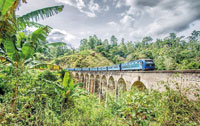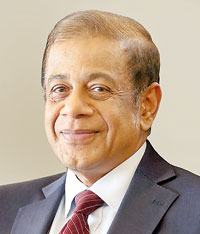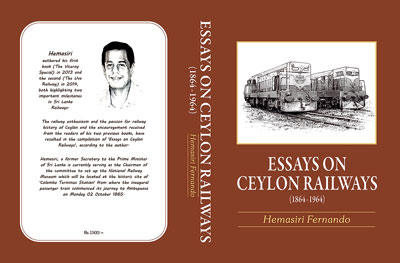Sunday Times 2
Book a ticket for a journey thru Ceylon Railways’ past
Hemasiri Fernando has done it again. He has come out with yet another book on Ceylon Railways. Best known as a sports administrator many would not know his twin passions for trains and stamps.
‘Essays on Ceylon Railways’ is his third book on Sri Lankan railways, the earlier ones being ‘The Viceroy Special’ (first publication January 2013 and third publication July 2015) and ‘The Uva Railway: Railway to the Moon (2014)’.

The book is more than a collection of essays of a technical nature on the Ceylon rail network.
His latest book presents a definitive and comprehensive history of the island’s rail network for the first hundred years (1864-1964). The volume comprises a series of essays covering an impressive range of topics narrated in an easy-to-read and easy-to-understand style. The author has brought out his talent for explaining complicated technical subjects in simple terms that an average reader can comprehend.
Included are technical appraisals of locomotive engines, evocative descriptions of some the country’s most spectacular routes and fascinating assessments of the technological innovations that made the Ceylon Railways, though comparatively small in terms of railway miles, one of the world’s great networks. Expertly threaded through the narrative are the historical turns that drove the network’s rapid development and the personalities that administered the service. The breadth of the volume will appeal to a wide readership, from the intrepid tourist, to seasoned train spotters, and many in-between.
Railway enthusiasts will find some indispensable reference reading, with rich detail provided about the evolution of Ceylon’s rolling stock from the early coal-fuelled steam locomotives to the later electric diesel models. Chapter 2 gives the readers an account of the bygone era of the iconic Garratt steam engines, which trundled up the steep inclines of the central hills to reach the bounty of lush tea plantations. From the 1930s these engines were phased out to accommodate the ubiquitous diesel locomotives we see today.
The technical transitions detailed in the essays are told through interesting anecdotes that engage the reader. In Chapter 1, the transition from steam to diesel, for example, is related by the author in the bittersweet story of Sri Lanka’s two ‘unluckiest engines’ intended to revolutionise the steam-driven network. They lasted only six months before a number of technical faults rendered them the shortest serving trains in the Ceylon Government Railways’ history. Despite their initial failure, the snippets of diesel capability provided impetus for the future dieselisation of the network, which culminated in the implementation of the ‘legendary’ Class M1 locomotive, the Canadian electric diesels, detailed in Chapters 6 and 7, respectively.
 As well as details of the rolling stock, the reader is provided with technical appraisals of other aspects of the network. In Chapters 4 and 12, we learn about the viaducts, tunnels and narrow gauge technology that permitted ever-more hazardous terrain to be conquered in the hill country. We are also provided a fascinating and rich account of signalling and safety features that provided the foundation for one of world’s great networks in Chapter 3. He has entwined his philatelic passion by dedicating Chapter 9 to explain not only the development of mail train system but also of the historical beginnings of the postal service in the island. The author’s interest in sports is highlighted when he identifies that ‘KV line is also probably the world’s only narrow gauge railway running through an 18 hole golf course…’(page 98).
As well as details of the rolling stock, the reader is provided with technical appraisals of other aspects of the network. In Chapters 4 and 12, we learn about the viaducts, tunnels and narrow gauge technology that permitted ever-more hazardous terrain to be conquered in the hill country. We are also provided a fascinating and rich account of signalling and safety features that provided the foundation for one of world’s great networks in Chapter 3. He has entwined his philatelic passion by dedicating Chapter 9 to explain not only the development of mail train system but also of the historical beginnings of the postal service in the island. The author’s interest in sports is highlighted when he identifies that ‘KV line is also probably the world’s only narrow gauge railway running through an 18 hole golf course…’(page 98).
The technical narrative accounts in the essays are supported with detailed reference material in the appendix, which provide a systematic inventory of rolling stock, as well as detailed diagrams of key railway infrastructure. The author has displayed unmatched energy and enthusiasm to source period and historic photographs which are spread throughout the book and in the appendix as well. The photo credit on page 11 is equally a testimony to the inimitable efforts of the author to provide the reader with the pleasure of viewing, as put in his own words, ‘…as many photographs as possible which were not appearing in any other book.’
This book is more than a collection of essays of a technical nature on the Ceylon rail network. The narrative runs on parallel tracks, so to speak, with the development of the network related in symbiosis with Ceylon’s history. In Chapters 3 and 4, we learn that some of the most spectacular rail routes through the hill country were built to facilitate the tastes of tea drinkers in the fashionable clubs of London and Colombo. The tea produced in the hitherto inaccessible Horton Plains included some of the most desired — and lucrative –varieties. The drive to access these prized commodities catalysed ever-more technical innovation, pushing the network further and further into the hill country.
Just as the technological progress led to the rise of the Ceylonese railways, they also led to its decline. It is with some regret, that the author notes motor vehicles eventually became the preferred mode of transport for people and goods across the island. This transition is vividly captured by the author in the story of the erstwhile Nuwara Eliya to Ragala line — a 19.5 mile stretch of narrow gauge line reminiscent of the Himalayan railway routes. The line, however, shared many of the same bridges and roads as motor traffic, and the running of the train often caused delays to road users. As a result of opposition from the increasingly powerful motor vehicle lobby, the line was eventually dismantled, bringing to an end one of the most spectacular journeys on the network.
 Although many aspects of the railway system and the Ceylon Government Railways (CGR) are discussed, it would have been welcome if a chapter was dedicated to the evolution of CGR as an iconic government entity (although it has declined in stature in recent decades). Readers would have enjoyed delving into the history behind some of the more prominent railway stations (junction stations are covered in Chapter 12.5) and railway quarters such as the revolving bungalow (bungalow of the railway engineer) situated amongst the Nuwara Eliya railway quarters. Details and the history behind the railway network which extended inside the Colombo port with complementary infrastructure would have made this book even more interesting.
Although many aspects of the railway system and the Ceylon Government Railways (CGR) are discussed, it would have been welcome if a chapter was dedicated to the evolution of CGR as an iconic government entity (although it has declined in stature in recent decades). Readers would have enjoyed delving into the history behind some of the more prominent railway stations (junction stations are covered in Chapter 12.5) and railway quarters such as the revolving bungalow (bungalow of the railway engineer) situated amongst the Nuwara Eliya railway quarters. Details and the history behind the railway network which extended inside the Colombo port with complementary infrastructure would have made this book even more interesting.
The volume contains many technical diagrams, which would not be accessible to the wider public if not for this book. However, some of these diagrams could have been bigger as the finer writings and details are difficult to decipher. Unlike his two previous volumes which were hardcover editions this book comes in paperback. For a book that can be considered as a compendium equating to an encyclopaedia of railway history of Ceylon it should have come as a hard cover edition.
Overall, this book provides the reader with many facets of development in the country not only during the British colonial period but also in the post-independence era and it will become a collector’s item and a reference book on the subject in the years to come. Anyone who has even a cursory interest in railways would undoubtedly hope that Hemasiri Fernando has gone back to his writing desk to start from where he stopped – to compile the history of Ceylon/Sri Lanka Railways for the next 50 years from 1964!

